Rewind the Clocks for Schedule's Sake
how 45-minute games force compromises in ESA Rewind's schedule
The ruleset announced for ESA Rewind make for a difficult schedule. I decided to take a look at how badly it messes things up.
First, for reference, the relevant part of the ESA Rewind ruleset that makes for difficult scheduling.
Ruleset: 45 minute timelimit, 5 round winlimit 5cp/4 round winlimit koth, two 120 second tactical pauses allowed per team per map
Each map thus needs to be allocated 45 minutes of time plus 8 minutes for tactical pauses (with both teams having 2 timeouts that last 2 minutes each), resulting in 53 minutes needing to be set aside per map. Thus, at bare minimum (and at risk of being unable to accommodate severe delays), single maps need to be given 1 hour each, and best-of-three series need to be given 3 hours each.
Three hours per series is difficult to schedule as it stands, but on top of things Rewind is a two-day tournament, which is very limited on time to begin with.
From the event page we have the following information for the schedule:
Friday January 20:
Door Opens 4:00 PM
Door Closes 12:00 AMSaturday January 21:
Door Opens 9:00 AM
Door Closes 12:00 AMSunday January 22:
Door Opens 9:00 AM
Door Closes 10:00 PMInvitational Tournament:
- $2,000+ Prize Pool
- January 21-22, 2017
- Start Time: 10:00am
Based on this we have 14 hours of time on Saturday (10AM-12AM) and 12 hours of time on Sunday (10AM-10PM). Since this is a full-day tournament, breaks for lunch and dinner are almost certainly required, so 2 hours must be taken out of each day for that, leaving a total of 22 hours for scheduling the actual games. Not very much time when you consider that best-of-three series take up 3 hours each.
Considerations
Given these scheduling parameters, what considerations are there to make for a tournament like this? I’d offer the following points:
- most matches broadcasted: for a tournament of this stature, with the best teams in the world and a couple of others in attendance, as many matches as possible should be broadcasted to showcase the high level of play. In the past, this has not been the case as matches have had to be run simultaneously, allowing only one match to be displayed at a time due to the lack of resources for the broadcast team.
- all matches on LAN: it’s an undeniable fact that matches are better when all teams are playing under equivalent and great conditions at LAN. With a tournament of this importance, all of it should be occurring at the event where there are no other factors at play.
- good format: the format of the tournament should be one such that the teams that are performing consistently badly within it finish worst and teams that are performing consistently well finish best. This generally means avoidance of formats where teams can be eliminated in short order (for example, through losing a couple of best-of-one games).
Is it possible to accomplish all three?
Possibilities
Unfortunately, no configuration with the constraints we are given fulfills all three of our considerations. Some of them can fulfill two to some extent.
There are two different formats I’ll be portraying. The first is round-robin groups, with all teams proceeding to a single-elimination bracket (with both a grand final for 1st/2nd and a consolation final for 3rd/4th). The second is round-robin groups feeding to a double-elimination bracket, where the top four proceed to the upper bracket and the bottom two proceed to the lower bracket.
Compromise Broadcasting
This has been the option utilized at Insomnia LANs. In essence, all matches of a given round are played simultaneously, but only one is broadcasted. This is not a great option given the small tournament size should make it possible to broadcast all matches, but may be the only way to proceed with the 45-minute ruleset.
(It’s important to note that in no example are all group matches casted, but doing so is a tall task and I believe casting all bracket matches is more attainable and significant.)
Single-Elimination Versions
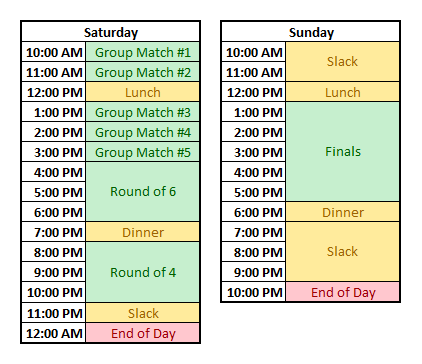
With this version, you get best-of-three series in the round of 6 and the round of 4, and best-of-five series for the two finals. Unfortunately, only three of the six bracket matches are broadcasted (with not even both finals shown). It’s possible to make the finals best-of-three and broadcast them both as well:
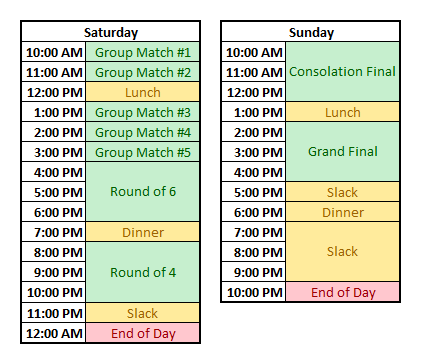
Other than not being able to broadcast all games, there’s not really any major compromises other than having to use a single-elimination bracket.
Double-Elimination Version
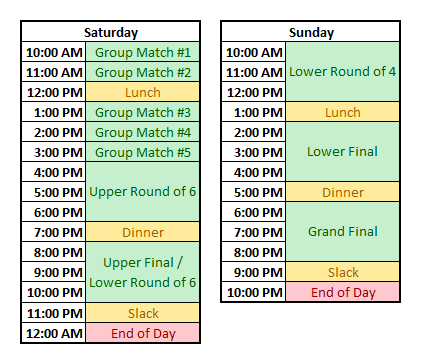
This version has best-of-three series all the way through the tournament. The format is the best that it can possibly be with the exception of the grand final not being best-of-five, which would be a nice addition. With this schedule, five of eight bracket matches are broadcasted.
Compromise Games on LAN
In order to increase time on the schedule to show more matches, one configuration is to play group matches online, which gives five hours on the first day but adds online play to the tournament.
Single-Elimination Version
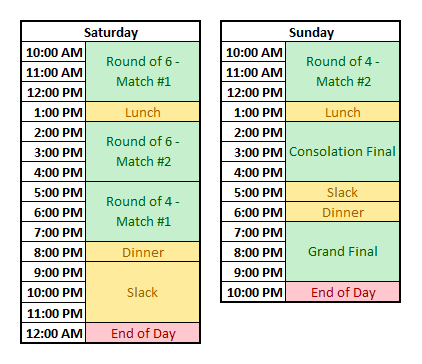
In this format, all games in the bracket are best-of-three, and all of them are broadcasted. Unfortunately, the groups are online, which means that some teams may be eliminated after only playing one match on LAN.
Double-Elimination Version
Unfortunately, there’s no way to make this work in the schedule.
Compromise Format
The worst idea is to compromise the format in order to make all of the games fit in the schedule with all of the bracket games broadcasted. There are two options available: either make the first round best-of-one, or eliminate the bottom two teams after the group stage. Both of these are compromises as eliminating teams before they can play a best-of-three isn’t ideal. All of the matches are played on LAN and the bracket is fully broadcasted, however.
Single-Elimination Versions
Eliminating two of the bottom four teams in a best-of-one after best-of-one groups is weird, but can be done:
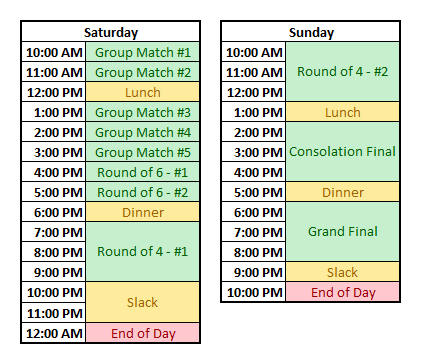
Eliminating the bottom two teams after groups makes more sense, but unfortunately the additional time gained by doing so doesn’t allow for best-of-five finals to work as an additional benefit:
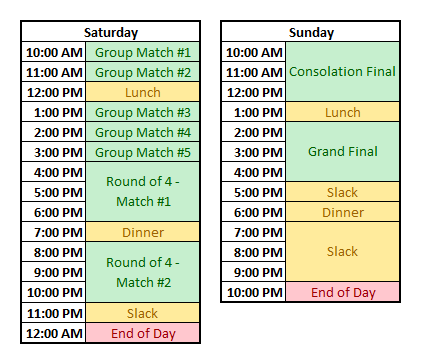
Double-Elimination Versions
The double-elimination best-of-ones are slightly better as the top four teams can only be eliminated by two best-of-one losses at worst, but it’s still not great.
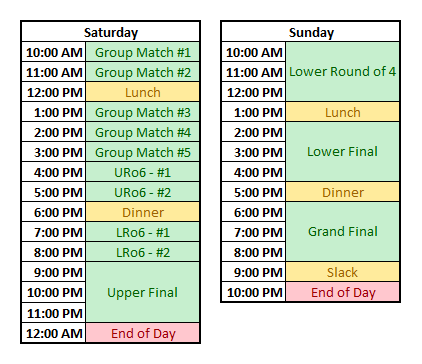
The grand final is also not best-of-five, which is another detriment.
Use the 30-Minute Ruleset
Of course, the ideal version which accomplishes all three must compromise something else entirely, and that is the 45-minute ruleset with timeouts. Going back to the standard ruleset of 30-minute games would allow best-of-threes to be played in two hours instead of three, which severely helps the schedule:
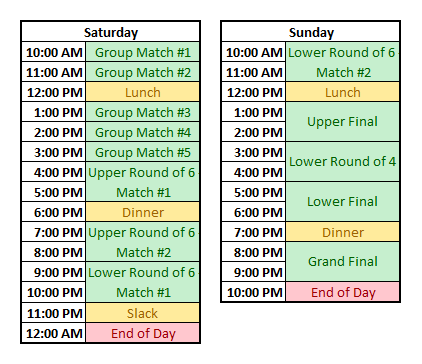
This format isn’t perfect — there’s still no way for all group stage matches to be broadcasted, and the grand final still isn’t best-of-five, but other than that the format accomplishes our three considerations (all matches on LAN, good format, and all bracket matches broadcasted) without significant compromise. The best-of-five restriction can even be worked around by cutting 15 minutes from each group match (which still leaves 15 minutes of slack around the 30-minute games) and moving the entire schedule up, allowing an extra bracket match to be played on Saturday and thus freeing up two hours on Sunday which can be used to extend the grand final to a best-of-five series.
Notes
I’ve made a number of assumptions in this article, such as the fact that Friday is not available for scheduling due to being a open play day, only one stream will be run, and the other tournaments (Halo:CE and Shadowrun) don’t have an impact on scheduling. This information isn’t readily available to me, and if these or other major facts change scheduling may become less or more difficult with the new constraints.
I also haven’t examined every single configuration for organizing the schedules. Instead, I have chosen these examples to be best-case scenarios that are generally representative of the configurations available. There may be other configurations that are subjectively more appealing than the ones presented above based on the reader, but I submit that these are the most palatable to all of the stakeholders involved.
Some will ask what experience I have with tournament organization as far as scheduling and formats go. Most notably, I was involved behind-the-scenes during the planning of Insomnia58. During that planning I successfully lobbied for an 8-team double-elimination bracket with the last two slots going to the top two from a open Swiss group, as opposed to the previously used format of a 16-team bracket with 10 slots going to teams based on open round-robin groups. I am drawing upon my experiences with organization there (including working significantly with the tournament admins nymthae and fiyahstorm) during the course of this article.
Final Thoughts on Rulesets
With all of these considerations, the question is: what is the significant need to test this ruleset out at a premier LAN event like this? We have already seen consequences when it comes to adopting new rulesets during such an event at Insomnia58, where the new coaching rules caused both logistical issues and many questions within the community. A premier LAN really shouldn’t need to be the testing ground for new rulesets whatsoever; instead, premier LANs should adopt rulesets thoroughly tested and accepted by the scene at large for the purposes of stability.
The main argument for the ruleset is that it is a compromise ruleset between all regions, but is there a need for this? The 30-minute ruleset is universally used across all scenes with the sole exceptions of ESEA and UGC. Even North American players, despite playing a 60-minute ruleset in matches, play a majority of their games with the 30-minute ruleset in both practice and non-league (i.e. lobby and pick-up game sites) settings. North American teams have also gotten used to playing the 30-minute ruleset at global LAN events as well. The reality is, the 30-minute ruleset has become a standard, and it is archaic rules in North America that keep it in place to this day.
Of course, I can respect the desire to try and improve the ruleset to address perceived problems (as some would call the European tendency for stalemates), and also the need to test it in a significant setting where players will take the ruleset seriously, but does it really need to be battle tested in a premier LAN, the most significant of settings? The same could be accomplished by placing money in a short tournament with the new ruleset, where the prize pot will incentivize players without the possibility of causing instability in a major event. If there’s a further desire to test the ruleset with international teams in order to gather meaningful feedback as part of a process to update the global ruleset, such a tournament could be held while the international teams are here—in other words, the week prior to the LAN during which they will most likely be bootcamping in preparation for the event.
Given all of this, I can only call the decision to use this ruleset at ESA Rewind a huge mistake. The invitational tournament at ESA Rewind should rightfully be a showcase of the highest level of play in competitive TF2, and I cannot ignore the almost-certainty that such a showcase would be compromised by adopting an experimental ruleset. As such, I would implore the organizers to revert to the original ruleset so that a tournament can be scheduled that allows for the most competition, fairness, and exposure.
